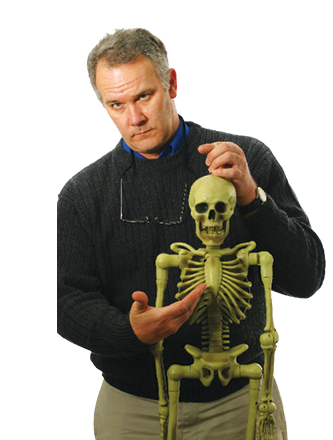
:dropcap_open:W:dropcap_close:ay back in 1997, I realized my wildly successful practice was, in fact, broken. And it all began with a simple question posed to me by a former high school classmate.
“Chris, where’ve you been?”
At the time, I had no answer. All day I had been busy. I saw a ton of patients, and each of their lives were improved because of the care my team and I were administering. I was feeling great about the direction my practice was going. Life was good…or so I thought.
It was summertime, which meant the sun was still shining when I left my office and drove to my daughter’s softball game around 7:30 p.m. A neighbor of mine, whose daughter was a teammate of my daughter’s, stopped me as I approached the diamond.
“Where’ve you been?” he asked. Still energized from my day, I didn’t notice his accusatory tone. I rambled on about how many patients I saw, how great I felt that I was changing lives, and how tired I was after a long, busy day.
“No,” he said. “Where’ve you been? The game’s almost over.”
I shot a glance at the scoreboard and my heart sank. It was the bottom of the last inning. The last batter was at the plate. I had missed it…again.
It was that moment…that horrible feeling…that made me realize I needed a change. I needed to build a better practice. The problem was I didn’t know where to start.
Sound familiar?
Regardless of where you’re at in your career, whether you’re like I was and you want to transform your clinic or you’re just starting out, building a practice is a scary proposition, and it’s never been more difficult than in 2012.
And why wouldn’t it be? You went to school to become a chiropractor, not a business professional. Sure, you probably thought you’d pick it up on the fly, but the reality is neither time, nor the banks, will wait for you to figure it out.
The majority of your work has been focused on becoming an expert in chiropractic techniques, not marketing, managing a staff, and running a real business.
Even if you give it your best, it might not be enough, because you likely don’t have all the answers…all the input.
:dropcap_open:An article from October of last year in The American Chiropractor reported that some 82 percent of practicing chiropractors nationwide struggle to pay their bills or don’t even pay them!:quoteleft_close:
An article from October of last year in The American Chiropractor reported that some 82 percent of practicing chiropractors nationwide struggle to pay their bills or don’t even pay them! You’ve probably heard that out of all chiropractic graduates, 50 percent fail and nearly 20 percent never even use the diploma, which many spend anywhere from $150,000 to $200,000 acquiring. That’s a large debt load to service.
Now that’s just plain stupid. How is our profession supposed to achieve the level of utilization it should have with numbers like that?
Today’s chiropractor can’t just be a skilled practitioner with an enviable bedside manner. Today’s chiropractor must always remember: you are no longer just a doctor… you’re a small business owner whose business should be delivering superior patient care.
That’s key, because the majority of your day is going to be spent running your practice, and not necessarily seeing patients.
Business never stops, and neither should your education

I have a list of success secrets taped to my bathroom mirror. I committed them to memory long ago, but I still enjoy the gentle reminder each and every morning. In fact, I keep the same list in my pocket, so that I’m always able to reflect when I need to, and pass on to others some of the principles that continue to resonate with me. I learned this habit from one of my mentors.
While each secret inspires me in different ways, #4 on the list may be the one that continues to impact my life on a daily basis: “Never Stop Learning.”
To maintain success you have to constantly change and grow. Sure, becoming a doctor of chiropractic is one heck of an achievement, but unless you’re setting your sights on the next accomplishment—maybe it’s growing your clinic and your impact on your community, or maybe it’s simply providing the best care possible to your patients—complacency always leads to mediocrity. Want to become a better doctor, a better person? Become a fountain of knowledge—always keep learning. Sharpen your tools.
Read books, take some classes, do whatever you have to so you can learn how to manage a staff, market your clinic, run systems analysis and everything else that keeps your practice moving forward.
And please don’t forget: If you practice today the way you did last year, your skills are already deteriorating. Improvements are constantly being made in how we can deliver exceptional care to our patients. Let’s keep our feet out of concrete and strive to be current, to be the best. Your patients deserve it!
Oh, and while you’re in education mode, pick up some books about leadership. One that I really like is Be Great by Peter Thomas. The bottom line is you’ve got to walk the talk. Once you start improving yourself, your ability to motivate your staff will improve, and that’s crucial to your success. You’ll need to train and motivate your team EVERY DAY so that your patients always have a 100 percent positive experience.
Here’s a real life example of how important this is: A colleague recently emailed me about having to replace a front desk team member who made it clear daily they did not want to be there. Negativity can become infectious real quick, and that’s exactly what happened. This employee’s attitude infected everyone. The replacement was the exact opposite, and her presence benefited the practice immediately. For starters, the numbers started climbing and future appointments shot up after her hire!

This new team member not only brought an exciting new energy, she never forgot that serving the patients was the reason she was there. She believed in the systems that were in place and truly wanted to be there because she knew she was improving the lives of the people who walked through those doors.
That’s how big a difference having the right people on the bus can make, and it’ll be your job to not only find them, but keep them in the proper frame of mind. Always remember to train your team to ask the simple question, “What’s best for patients?” Then do it.
Some other ways to strengthen your business sense:
If you want to become a master at spotting short-term negative trends before they become financial quagmires, you’ll need to become familiar with tracking EVERYTHING. You’d be surprised how much a solid metrics analysis system can bolster the efforts of you and your team.
Also, research other successful businesses and adopt the same techniques to make your practice run effectively and efficiently. This will likely lead you down the path to systemization—it’s no secret I’m a firm believer in an office that runs on autopilot, an office with systems.
Most chiropractic clinics are personality dependent, which means if the lead doc takes a two-week vacation, patients won’t schedule their appointments until he or she returns. You need your patients to feel comfortable no matter who they interact with, and you’ll do that by having effective systems in place – systems for incredible care and systems to allow you to unplug while the office runs at peak performance.
Money: Why Can’t It Grow On Trees?
Starting a clinic is going to be expensive. Equipment. Staff salaries. Utility bills. Lease or mortgage payments. Plus a marketing budget to let people know what great services you offer.
You’ll need at least six months of capital to get you going. The worst thing that can happen is your business starts to pick up steam, but then you run out of money because you didn’t fund it properly.
For most docs this means pulling out bank loans, and that isn’t as easy as it used to be. Before the Great Recession struck, getting a loan was as easy as having a pulse. Not any more, and especially not for those with poor credit.
:quoteright_open:You’ll need at least six months of capital to get you going.:quoteright_close:
Making yourself attractive to banks is more about what you don’t do than what you do. Don’t, for example, rack up a bunch of credit card debt while you’re in school. You’re a student, live like it. Also, it’s a good idea to have money saved up. Having at least 20 percent down will not only make those monthly payments easier to handle, but will make you look like you have the discipline not to default on the loan.
You don’t have to go it alone
A few months ago I sat down with a young man who had just graduated chiropractic school. He told me his plan was to open his own practice somewhere close to where he grew up in Columbus, Ohio.
It had been his dream to start his chiropractic career by opening his own practice, rather than work as an associate, and he wanted it sooner rather than later. The problem is he didn’t have the cash, and after I told him all that went in to owning a clinic, he was perplexed. He had no idea. The key is to have mentorship readily available when opening a new practice.
Owning your own practice is great. It gives you the freedom to treat patients the way you want to, and you always leave your office feeling good that you changed lives.
And there’s nothing wrong with spending a few years under the wing of an established chiropractor. Find someone whom you admire, someone who already has success in the field, and ask them to mentor you. Most docs will jump at the chance to share their knowledge. We all get into this field for the same reason: To make the lives of our patients better!
Improve yourself
You want to be successful? Here’s a little trick I’ve learned: Wake up early. Michael Masterson, in his book Automatic Wealth, talks at great lengths about this.
What does this mean to a practicing doc, busy all day with patients? It means this: Set your alarm clock an hour earlier than you would normally wake up. If you want to be successful and do what successful docs do, instead of watching the news, you’ll jump out of bed early enough to attack the day. First, read your goals and affirmations. Do some quality reading. Start the day by programming your mind for success. Skip the news entirely.
:dropcap_open:You want to be successful? Here’s a little trick I’ve learned: Wake up early.:quoteleft_close:
Morning is also a great time to exercise. If I don’t work out right in the morning, it just doesn’t get done, and this is such an important step. You must maintain your health if you want to preach to others about theirs. While you’re working out, listen to audio books so that you’re feeding your mind while improving your body.
Remember: successful doctors do what unsuccessful doctors refuse to do. It costs you nothing to wake up an hour earlier, and before you know it, 30 days later, it becomes part of your routine. Be diligent.
Steve Prefontaine, an Olympic runner from back in the 70s, had an awesome quote, which was “to give anything less than your best is to sacrifice the gift.” Let’s not sacrifice the gift. Live to your full potential.
Building a practice in 2012 can be a struggle, but if you understand first what you must do to reach that point, it will be a whole lot easier. Even if you’ve got a successful practice now, make sure you hold on to that success by continuing to change and grow. It took me feeling like I let my daughter down to evolve my thinking and actions. Don’t let it get to that point for you. Now get to work!
Chris Tomshack, D.C., is CEO of HealthSource Chiropractic and Progressive Rehab® and currently oversees 346 offices throughout the nation. By supplying its doctors with a comprehensive set of systems, HealthSource positions its clinics to provide a singularly unique health care experience to patients, while focusing on community outreach and educational programs. HealthSource Chiropractic can be reached by calling 440-934-5858. For more information on HealthSource go to www.HealthSourceChiro.com
 The first major barrier to building medical relationships is your ability, as ridiculous as it may seem, to convey your diagnostic skills to the MD. The first family practice resident that I had in my office for the chiropractic elective at the State University of New York at Buffalo School of Medicine and Biomedical Sciences actually said, “I am surprised at the level of detail in your initial examination.” Medical providers do not receive any exposure to chiropractic practice; therefore the default reasoning is chiropractic care is sub-par. While we know this to be untrue, it is the reality nonetheless. I have said it before and I’ll keep saying it, the medical community does not care at all about your technique. They refer based on trust and clinical reputation. They need to be able to trust that you will be able to take care of their patients. Can you and your office handle complex cases and manage patients in a collaborative environment? Does the medical community in your area know?
The first major barrier to building medical relationships is your ability, as ridiculous as it may seem, to convey your diagnostic skills to the MD. The first family practice resident that I had in my office for the chiropractic elective at the State University of New York at Buffalo School of Medicine and Biomedical Sciences actually said, “I am surprised at the level of detail in your initial examination.” Medical providers do not receive any exposure to chiropractic practice; therefore the default reasoning is chiropractic care is sub-par. While we know this to be untrue, it is the reality nonetheless. I have said it before and I’ll keep saying it, the medical community does not care at all about your technique. They refer based on trust and clinical reputation. They need to be able to trust that you will be able to take care of their patients. Can you and your office handle complex cases and manage patients in a collaborative environment? Does the medical community in your area know?

 Most analysts that work with overachievers and other highly successful people admit that they all have one thing in common – they think big. As Steve Jobs from Apple, Inc. once said, “Dream bigger.” This is not about living in fairy tale land, but rather sitting down and developing a solid plan for your practice to increase in all areas. More patients, more revenue and a better level of service should all be part of your “Think Big” plan. It is all about increasing the performance of your practice to meet your expectations.
Most analysts that work with overachievers and other highly successful people admit that they all have one thing in common – they think big. As Steve Jobs from Apple, Inc. once said, “Dream bigger.” This is not about living in fairy tale land, but rather sitting down and developing a solid plan for your practice to increase in all areas. More patients, more revenue and a better level of service should all be part of your “Think Big” plan. It is all about increasing the performance of your practice to meet your expectations.

 corresponding fundamental solution) is that DCs spend the vast majority of their non-patient business time reacting to issues related to employees, marketing, insurance, practice management, etc. These and other “urgent” tasks, issues, disturbances, and time-wasters consume their business days. This vicious reactionary cycle de-leverages their time and energy, and diminishes their ability to achieve their full potential. Since less than 3% (or even less) of the population regularly sees a chiropractor, I believe that the profession can be saved, if and only if the individual chiropractor can be saved FIRST.
corresponding fundamental solution) is that DCs spend the vast majority of their non-patient business time reacting to issues related to employees, marketing, insurance, practice management, etc. These and other “urgent” tasks, issues, disturbances, and time-wasters consume their business days. This vicious reactionary cycle de-leverages their time and energy, and diminishes their ability to achieve their full potential. Since less than 3% (or even less) of the population regularly sees a chiropractor, I believe that the profession can be saved, if and only if the individual chiropractor can be saved FIRST. My wife and I know that we’re not going to guarantee that we’ll be celebrating our 50-year wedding anniversary in four decades, just because we learned a new way of communicating in a book. What goes for health, goes for marriage, and also goes for business… If you have a firm grasp through knowledge, deep understanding, and practice of the foundational principles of ANYTHING, you radically increase your long-term opportunities, value-creation, and satisfaction. And the most satisfying thing for a chiropractic office is a thriving patient community, a thriving staff, and a thriving bank account, with several opportunities to grow the business – or sell the business for that matter – when the time is right. Since you’re putting in the time and effort every minute of every day, of every week, why wouldn’t you like to have more certainty about how to increase the probability of your ultimate business success and value?
My wife and I know that we’re not going to guarantee that we’ll be celebrating our 50-year wedding anniversary in four decades, just because we learned a new way of communicating in a book. What goes for health, goes for marriage, and also goes for business… If you have a firm grasp through knowledge, deep understanding, and practice of the foundational principles of ANYTHING, you radically increase your long-term opportunities, value-creation, and satisfaction. And the most satisfying thing for a chiropractic office is a thriving patient community, a thriving staff, and a thriving bank account, with several opportunities to grow the business – or sell the business for that matter – when the time is right. Since you’re putting in the time and effort every minute of every day, of every week, why wouldn’t you like to have more certainty about how to increase the probability of your ultimate business success and value? 

 The first thing that needs to be done when building a paperless office is to convert all one’s existing paper documents into electronic format. There are a variety of chiropractic software programs that can help you with this conversion. All documents are scanned into digital files for use in record keeping applications like chiropractic soap notes systems.
The first thing that needs to be done when building a paperless office is to convert all one’s existing paper documents into electronic format. There are a variety of chiropractic software programs that can help you with this conversion. All documents are scanned into digital files for use in record keeping applications like chiropractic soap notes systems.
 There is no way you can do your own construction and save money. Imagine painting your own office. You’ll have to purchase ladders, drop cloths, rollers, paint brushes, paint, paint thinner, etc… then you’ll have to spend hours doing the work… and then cleaning up. Can you paint your space cheaper than a professional painter? Heck no! Remember, the professional painter already owns his ladders, rollers, paint brushes, drop cloths, etc… he won’t have to purchase them and he’ll know how to cover twice as much wall space with less paint. And he’ll finish your paint job in 2 days vs. you doing so in one week.
There is no way you can do your own construction and save money. Imagine painting your own office. You’ll have to purchase ladders, drop cloths, rollers, paint brushes, paint, paint thinner, etc… then you’ll have to spend hours doing the work… and then cleaning up. Can you paint your space cheaper than a professional painter? Heck no! Remember, the professional painter already owns his ladders, rollers, paint brushes, drop cloths, etc… he won’t have to purchase them and he’ll know how to cover twice as much wall space with less paint. And he’ll finish your paint job in 2 days vs. you doing so in one week. 
 :dropcap_open:W:dropcap_close:ay back in 1997, I realized my wildly successful practice was, in fact, broken. And it all began with a simple question posed to me by a former high school classmate.
:dropcap_open:W:dropcap_close:ay back in 1997, I realized my wildly successful practice was, in fact, broken. And it all began with a simple question posed to me by a former high school classmate. I have a list of success secrets taped to my bathroom mirror. I committed them to memory long ago, but I still enjoy the gentle reminder each and every morning. In fact, I keep the same list in my pocket, so that I’m always able to reflect when I need to, and pass on to others some of the principles that continue to resonate with me. I learned this habit from one of my mentors.
I have a list of success secrets taped to my bathroom mirror. I committed them to memory long ago, but I still enjoy the gentle reminder each and every morning. In fact, I keep the same list in my pocket, so that I’m always able to reflect when I need to, and pass on to others some of the principles that continue to resonate with me. I learned this habit from one of my mentors. This new team member not only brought an exciting new energy, she never forgot that serving the patients was the reason she was there. She believed in the systems that were in place and truly wanted to be there because she knew she was improving the lives of the people who walked through those doors.
This new team member not only brought an exciting new energy, she never forgot that serving the patients was the reason she was there. She believed in the systems that were in place and truly wanted to be there because she knew she was improving the lives of the people who walked through those doors.
 I am not talking about assimilating into the medical model, running a MD/DC practice or being afraid to talk Subluxation to medical providers. I know for a fact that you can have the referrals and stay genuine to the chiropractic model, which is why the MD sends referrals to me and not the physiatrist or PT. The beauty is in chiropractic being a separate and distinct profession doing what no other health profession does. MDs will listen to and understand the chiropractic model, as long as it is not given to them as though they were a patient. There is a HUGE difference between a patient report of findings and an MD report of findings. The major tenets of chiropractic are why we are the third largest healing profession in the United States, and we need to be better at explaining it instead of running away from it. After all, it has gotten us this far hasn’t it?
I am not talking about assimilating into the medical model, running a MD/DC practice or being afraid to talk Subluxation to medical providers. I know for a fact that you can have the referrals and stay genuine to the chiropractic model, which is why the MD sends referrals to me and not the physiatrist or PT. The beauty is in chiropractic being a separate and distinct profession doing what no other health profession does. MDs will listen to and understand the chiropractic model, as long as it is not given to them as though they were a patient. There is a HUGE difference between a patient report of findings and an MD report of findings. The major tenets of chiropractic are why we are the third largest healing profession in the United States, and we need to be better at explaining it instead of running away from it. After all, it has gotten us this far hasn’t it? 
 Matter of fact, the myth upon graduating simply isn’t true. We’ve all heard it before: Get your degree, drive down the road until you run out of gas, throw up a shingle, and watch the new patients flood in. Any chiropractor practicing in today’s economy will tell you it’s simply not true!
Matter of fact, the myth upon graduating simply isn’t true. We’ve all heard it before: Get your degree, drive down the road until you run out of gas, throw up a shingle, and watch the new patients flood in. Any chiropractor practicing in today’s economy will tell you it’s simply not true!




 Depending on relatives to build your practice? It will never happen.
Depending on relatives to build your practice? It will never happen.